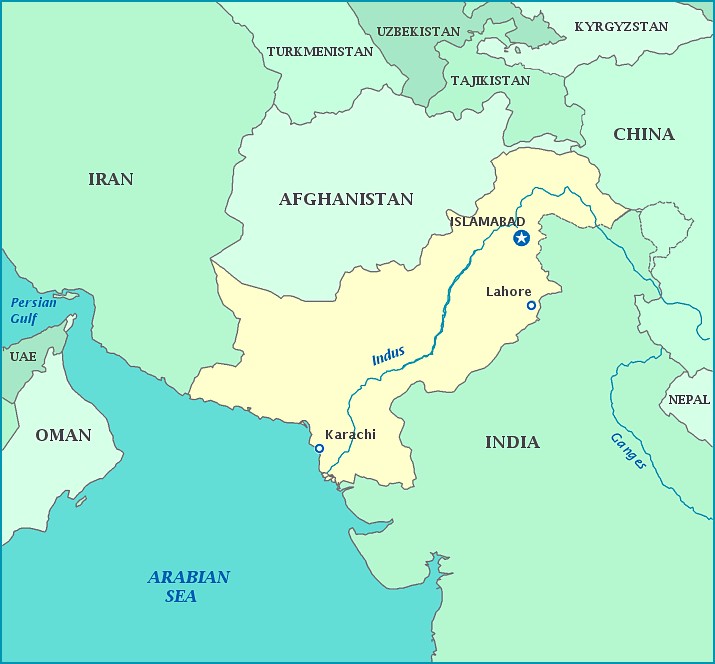
Quill's Quiz - 1100 Question US Mega Geography Quiz
Print this map of Pakistan US States and Capitals Map Quiz
Free Maps, Map Puzzles and Educational Software: Owl and Mouse Educational Software
Print this map of Pakistan US States and Capitals Map Quiz
Free Maps, Map Puzzles and Educational Software: Owl and Mouse Educational Software
Pakistan
The Islamic Republic of Pakistan is made up of 4 provinces and 4 territories in which over 60 languages are spoken. It is the 6th most populous country in the world, the second most populous Muslim-majority country, and the 8th largest exporter of textiles. The name Pakistan means 'Land of the Pure' in Persian and Urdu.
The first organized human habitation in the region was the Indus Valley civilization of the early Bronze Age. This became the Vedic Empire, one of the first in the world. The Empire lasted from 1500-500 BCE, laying the foundations for Indian culture, including the Hindu religion. The area had many successive rulers, most spanning for hundreds—some thousands—of years, including the Mauryan Empire, the Persian Achemeid Empire, Arab Ummayyad Caliphate, Mongolian Empire, Mughal Empire, Durrania Empire, Sikh Empire, and British Empire. In the medieval period, Islam arrived by way of missionaries. The Last Buddhist dynasty to rule what is now Pakistan was the Pala Empire. Arab general Muhammad bin Qasim conquered the Indus Valley in 711 CE, the territory laying down the basis for what would become Pakistan and the rule of several successive Muslim Empires, ending with the Mughals in 1827 and declining in the previous century.
Taking advantage in the weakened of the Mughal empire, the British East India Company was quick to buy up land, using force to take over the rest of the region, As well as India and other Southeast Asian countries. The natives did not take this calmly. In 1857, the largest armed rebellion fought against the British East India Company and lost. Protests resumed in the 1920's and 1930's along with India in the form of mass civil disobedience. While the protests supported an independence from Britain, so too was a growing desire for an independence from India as a Muslim nation with the All-Indian Muslim League established in the 1930's. The Lahore Resolution, more commonly known as the Muslim Resolution, was proposed at Independence in 1947.
Pakistan became independent along with India in 1947 as an Independent nation for Muslims. Immediately following this, hundreds of thousands of Muslims moved to Pakistan while hundreds of thousands of Hindus, Buddhists, Sikhs, and Jains made an exodus to India. Although the country became a republic in 1956, the country now is characterized by political threats, coercion, and outright authority by the military. A year after the first elections were held nationwide, citizens of Bangladesh voted to leave the country and form their own in 1971, earning independence and resentment by the military. Bangladesh quickly earned political and military aid from India, just in time for Pakistan to invade. The genocide committed by the Pakistan army against those in Bangladesh killed somewhere between 3,000,000-300,000,000; Pakistan claims it was a civil war and it was retaking Bangladesh to unite the country. Pakistan had tried several times to take the provinces of Jammu and Kashmir, the latter of which it controls 38.2 percent of, form Bangladesh and India; violence is practically omnipresent and four times has turned into all out war—in 1947, 1965, 1971, and 1999. The violence is so great, technology such as Windows 95 has been banned for claiming the opposite region owned the provinces. Pakistan armed forces are the 8th largest in the world.
Even after Independence, British kings and queens were considered monarchs of the county until the establishment of the republic. Part of Pakistan lies past the Indian tectonic plate, putting much of the country in danger of earthquakes. The country is divided in three regions: Northern Highlands, Indus River Plains, and the Baluchistan Plateau; because of these very different regions, the climate varies from tropical to temperate, though they all see monsoon seasons. Pakistan is home to many animals of various levels of being endangered; these include snow leopards, Asiatic cheetahs, blind Indus dolphins (of which there are only 1,100 remaining), and more. All animal and plant species are in danger mainly due to pollution and deforestation.
Area: 796,095 sq km
Population: 196,174,380 (2014)


